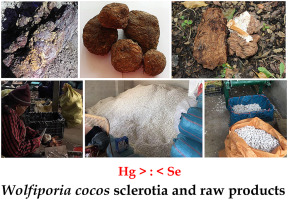当前位置:
X-MOL 学术
›
Chemosphere
›
论文详情
Our official English website, www.x-mol.net, welcomes your feedback! (Note: you will need to create a separate account there.)
Occurrence, distribution and estimated intake of mercury and selenium from sclerotia of the medicinal fungus Wolfiporia cocos from China.
Chemosphere ( IF 8.8 ) Pub Date : 2020-01-21 , DOI: 10.1016/j.chemosphere.2020.125928 Jerzy Falandysz 1 , Martyna Saba 2 , Ji Zhang 3 , Anetta Hanć 4
Chemosphere ( IF 8.8 ) Pub Date : 2020-01-21 , DOI: 10.1016/j.chemosphere.2020.125928 Jerzy Falandysz 1 , Martyna Saba 2 , Ji Zhang 3 , Anetta Hanć 4
Affiliation

|
The contamination and distribution of mercury and selenium in the Chinese medicinal fungus Wolfiporia cocos was investigated. The sclerotial mercury concentrations ranged from 0.0043 to 0.027 mg kg1 dry biomass (db) in the inner white part and 0.019-0.074 mg kg-1 db in the shell (outer part), while selenium concentrations ranged from < 0.00048 to 0.0040 mg kg-1 db (white) and 0.0034-0.038 mg kg-1 db (shell). Positive correlations were found for mercury, as well as for mercury and selenium but they were not consistent for both morphological parts. Mercury concentrations exceeded selenium in 16 of 17 white part pools (molar quotient 0.53 to > 10) and in 11 of 17 shell pools (quotient 0.37 to 3.2). The estimated maximal exposure to mercury contained in sclerotial products based on 45 g per capita daily intake for a 60 kg individual over one week, was 0.000020 mg kg-1 body mass (bm; white) and 0.000055 mg kg-1 bm (shell) on a daily basis, and 0.00014 mg kg-1 bm (white) and 0.00039 mg kg-1 bm (shell) on a weekly basis. Relative to mercury, the corresponding intake rates of selenium were considered very low, i.e., they averaged on a daily basis at 0.00075 μg kg-1 bm (white) and 0.0097 μg kg-1 bm (shell) with maximum intake at 0.0030 μg kg-1 bm (white) and 0.028 μg kg-1 bm (shell).
更新日期:2020-01-22



























 京公网安备 11010802027423号
京公网安备 11010802027423号